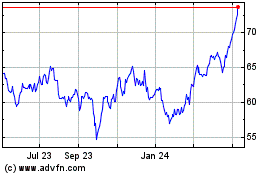UPDATE: Modeling: US Reactor Comes Within Hour Of Core Damage
April 06 2011 - 11:58AM
Dow Jones News
An analysis of hypothetical nuclear accidents conducted by U.S.
nuclear officials shows that a reactor in Pennsylvania, known as
Peach Bottom, comes close to suffering core damage in situations
where all power is lost at the plant, House Democrats said.
The study, known as State-of-the-Art Reactor Consequence
Analyses and conducted by the U.S. Nuclear Regulatory Commission,
analyzed the effects of severe accidents at two nuclear reactors:
the Peach Bottom plant, which has a design similar to the damaged
Fukushima Daiichi plant in Japan, and the Surry reactor in
Virginia, Democrats said.
Under one scenario, in which a severe station blackout takes out
all power, the simulation analysis showed that the Peach Bottom
reactor "came within one hour of core damage," according to a memo
House Democrats released Wednesday.
"A simulated meltdown was narrowly averted through the manual
turning of steam valves" to activate cooling systems, the memo
said.
In a less-severe scenario, in which the plant has access to
backup battery power for four hours, the operator was able to
prevent core damage.
In a House hearing Wednesday, a top nuclear official responded
to the report and said the analysis of nuclear accidents looked at
"very unrealistic events."
"We ignore all probabilities" of the events actually taking
place, said Martin Virgilio, deputy executive director for reactor
and preparedness programs at the Nuclear Regulatory Commission.
"We're testing the envelope."
In conducting its hypothetical simulations, the NRC assumed the
Peach Bottom nuclear plant used new equipment and procedures
introduced since the Sept. 11 terrorist attacks, the memo said.
Without that equipment, the simulation showed the plant would
suffer core damage and would release radioactive contamination in
two days.
There appeared to be some disagreement among U.S. nuclear
officials, however, regarding the effectiveness of the new
equipment and procedures. According to July 28 email among NRC
officials, referenced in the memo, senior analysts at the
commission said the new equipment and procedures "have really not
been reviewed to ensure that they will work to mitigate severe
accidents."
The email identified specific concerns about operating the
Reactor Core Isolation Cooling system without battery power, the
Democrats said in the memo. This is the same system that allowed
the plant to avert core damage in the simulations.
NRC's Virgilio said the email reflect the "healthy debate" that
occurs among commission staff.
"Our staff is encouraged to challenge various issues as they're
being evaluated," Virgilio said.
The purpose of Wednesday's hearing, held by a House Energy and
Commerce subcommittee, was to analyze events at Tokyo Electric
Power Co.'s (9501.TO) Fukushima Daiichi plant in Japan. Following a
March 11 earthquake and tsunami, the plant lost crucial cooling
systems, causing damage that has led to leaked radiation.
Rep. Ed Markey (D., Mass.), a critic of nuclear power, said in a
statement that the NRC believes the core of Unit 2 at the Fukushima
plant has "gotten so hot that part of it has probably melted
through the reactor pressure vessel." Markey also said that at
least one other reactor core has been severely damaged.
The Peach Bottom Atomic Power Station plant is jointly owned by
Exelon Corp. (EXC) and Public Service Enterprise Group Inc. (PEG)
and operated by Exelon. The Surrey Power Station is owned by
Dominion Resources Inc. (D).
-By Tennille Tracy, Dow Jones Newswires; 202-862-6619;
tennille.tracy@dowjones.com
Public Service Enterprise (NYSE:PEG)
Historical Stock Chart
From May 2024 to Jun 2024

Public Service Enterprise (NYSE:PEG)
Historical Stock Chart
From Jun 2023 to Jun 2024
